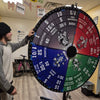Trade shows are no longer about showing up with a backdrop and a stack of brochures. Today’s attendees expect meaningful experiences, and the brands that stand out are the ones that balance strategy with creativity. Here’s a practical framework you can use to plan your next show.
1. Plan Your Space for Flow
A great booth isn’t about how much you can fit—it’s about how people move through it. Thoughtful layout design can make the difference between a crowded corner and a destination space.
- Sketch your booth like a floor plan. Identify entrances, traffic corridors, and where people naturally pause.
- Designate “zones.” For example: a demo zone, a networking zone, and a quick-activation zone.
- Think sightlines. Make sure your main visuals and focal points are visible from at least 15–20 feet away.
- Place Attraction Strategically. If you’re incorporating a promotional game like a prize wheel, place it at the edge of your booth to draw people in without creating a bottleneck.
2. Build Engagement in Layers
Trade show attendees are busy and distracted—you need to engage them quickly and give them reasons to stay. Layering simple interactions with deeper conversations keeps your booth dynamic.
- Lead with visual hooks. Lighting, elevated signage, or a unique display element should catch attention first.
- Offer micro-interactions. A spin-to-win wheel or mini-game can be a quick way for attendees to engage while your staff begins a conversation.
- Have a next step ready. Once someone engages, transition them to a product demo, portfolio showcase, or staff Q&A.
- Keep promotional games simple. Let attendees enjoy the moment but still play in under 30 seconds.
3. Collect Smarter, Not Just More
The real value of a trade show is in the leads you leave with. Moving beyond badge scans to meaningful data ensures your post-show follow-up is sharp and effective.
- Go beyond badge scans. Use quick surveys, QR codes, or game entries to capture context (like product interest or purchase timeline).
- Automate lead capture. Connect your forms to your CRM so every game entry or scan immediately populates your pipeline.
- Incentivize quality responses. Attendees are more likely to share useful info when it’s tied to an engaging activity.
- Prize wheels can double as data capture. Ask for a business card or digital sign-up before the spin.
4. Extend the Experience After the Show
What happens after the show is as important as what happens on the floor. Extending your booth’s energy into follow-ups and content multiplies your ROI.
- Plan content capture. Use video clips of people playing a game or winning a prize as social posts.
- Follow up quickly. Within 48 hours, send a tailored email referencing the interaction (“Hope you enjoyed spinning the wheel at our booth!”).
- Repurpose assets. Choose games and branded fixtures that can be used again at future shows, in-store activations, or even internal events.
Final Thoughts
Trade show success doesn’t happen by chance—it’s planned through flow, engagement, data, and follow-up. By layering in practical tools like promotional games alongside strong design and messaging, you create not just a booth, but a full brand experience that connects, converts, and continues well beyond the show floor.






